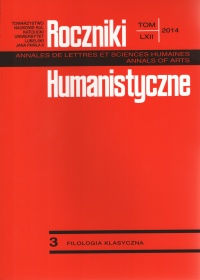The Metaphor of Death and the Archetype of Indestructible Life
Abstract
Deliberations concerning the Greek metaphor of death and the archetype of indestructible life functioning in the Greek literature are the subject of the article. Their close correlation is most completely expressed by the graus methyse—anus ebria topos. For a proper understanding of the wealth of its meanings and symbols the cultural context is shown, in which the topos was created. In the article the phenomenon of the old age in Greek literature is analyzed in two basic aspects. The first one is perceiving the old age as contrasted with the worship of beauty and youth worked out by the antiquity; and the other one is showing it in the context of death, especially as compared with the symbolic image of Hades. The latter is accompanied by visions of overcoming the death that function in the Greek culture and are recorded in literature. One of them is presented in the symbolic image of graus methysē—anus ebria that is connected with the state of intoxication with wine and its benevolent giver, Dionysus.
References
Borowicz S., Czerwińska J.: O eschatologii siły i upojenia w sztuce i literaturze V w. p.n.e., w: Egzystencjalne doświadczenie starości w literaturze [The existential experience of Old Age in the literature], pod red. I. Jokiel, M. Szladowski, Opole: Wydawnictwo Uniwersytetu Opolskiego 2008, s. 281-307.
Cole S.G., Voices from beyond the Grave: Dionysos and the Dead, w: Mask of Dionysus, ed. Th.H. Carpenter and Ch.A. Faraone, Ithaca–New York: Cornell University Press 1993, s. 277-295.
Czerwińska J.: GRAVS METHYSE – ANVS EBRIA, w: Colloques, Congrés et Conférences sur la Renaissance Européenne 78, Le cabinet du curieux. Culture, savoirs, religion de l’Antiquité à l’Ancien Régime. Études et essais en l’honneur de Jean-Paul Pittion, éd. M. Koźluk, W.K. Pietrzak, Paris: Éditions Classiques Garnier 2013, s. 33-47.
Czerwińska J.: Hercules furens – A Euripidean Allegory of Human Madness, „EOS” 92 (2005), fasc. 2, s. 161-182.
Czerwińska J.: Człowiek Eurypidesa wobec zagrożenia życia, namiętnej miłości i ekstazy religijnej, Łódź: Wydawnictwo Uniwerytetu Łódzkiego 1999.
Czerwińska J.: Fantastyka i baśniowość w „Alkestis” Eurypidesa [Le fantastique et le surnaturel dans l’Alceste d’Euripide], w: Thaleia. Humor w antyku, red. G. Malinowski, Classica Wratislaviensia XXIV, Wrocław: Wydawnictwo Uniwersytetu Wrocławskiego, 2004, s. 18-33.
Czerwińska J.: Motywy prodikejskie w koncepcji śmierci u Eurypidesa [Die Motive von Prodikos in der Konzeption des Todes bei Euripides], „Collectanea Philologica” 2 (1995), s.65-79.
Diller H.: Die Bacchen und ihre Stellung in Spätwerk des Euripides, Meinz: Verlag der Akademie der Wissenschaften und der Literatur 1955.
Dodds E.R. (ed.): Euripides, Bacchae, Introduction and Commentary, Oxford 1960.
Eurypides: Tragedie, przeł. J. Łanowski, t. 1-3, Warszawa: PIW 1967-1980.
Euripides: Tragoediae. Perditarum tragoediarum fragmenta, recensuit A. Nauck, Lipsiae: Teubner 1908.
Hezjod: Prace i dni, w: Hezjod, Narodziny bogów (Theogonia). Prace i dni. Tarcza, przeł. J.Łanowski, Warszawa: Prószyński i S-ka 1999.
Humboldt W. von: Über das vergleichende Sprachstudium in Beziehung auf die verschidenen Epochen der Sprachentwicklung, 1820 (Gesammelte Schriften IV, Berlin 1905).
Kerényi K.: Dionizos. Archetyp życia niezniszczalnego, przeł. I. Kania, Kraków: Wydawnictwo Baran i Suszczyński 1997 (wznowienie Warszawa: Wydawnictwo Aletheia 2008).
Klemens Aleksandryjski: Kobierce zapisków filozoficznych dotyczących prawdziwej wiedzy, t. I, z języka greckiego przeł., wstępem, komentarzem i indeksami opatrzyła J. Niemirska-Pliszczyńska, Warszawa: Instytut Wydawniczy PAX 1994.
Kubiak Z.: Antologia Palatyńska, Warszawa: PIW 1978.
Lakoff G., Johnson M.: Metafory w naszym życiu, przeł. T.R. Krzeszowski, Warszawa: PIW 1988.
Lengauer W.: Dionizos w świecie zwierząt, „Przegląd Historyczny” 87 (1996), z. 2, s. 305-317.
Liryka starożytnej Grecji, oprac. J. Danielewicz, Warszawa–Poznań: PWN 1996.
Nestle W.: Die Vorsokratiker, Jena: E. Diederichs 1922.
Nowicki A.: Starożytni o religii, Warszawa: PTR 1959.
Owidiusz: Metamorfozy, przeł. A. Kamieńska (ks. I – ks. IX, w. 175) i S. Stabryła (ks. IX, w.176 – ks. XV), opr. S. Stabryła, BN, wydanie drugie zmienione, Wrocław–Warszawa–Kraków: Ossolineum 1995.
Pauzaniasz: W świątyni i w micie. Z Pauzaniasza Wędrówki po Helladzie księgi I, II, III iVII, przeł. z języka greckiego i oprac. J. Niemirska-Pliszczyńska, Warszawa: DeAgostini 2005.
Rybowska J.: Διόνυσος Κισσός (Dionysos Master of Ivy), „Collectanea Philologica” 11 (2008), s. 21-34.
Schmid W., Stählin O., Geschichte der griechischen Literatur, München 1940.
Zalewska-Jura H.: W rytmie sikinnis. Studium nad warstwą aluzji i podtekstów w greckim dramacie satyrowym, Łódź: Wydawnictwo Uniwerytetu Łódzkiego 2006.
Copyright (c) 2014 Roczniki Humanistyczne

This work is licensed under a Creative Commons Attribution-NonCommercial-NoDerivatives 4.0 International License.





